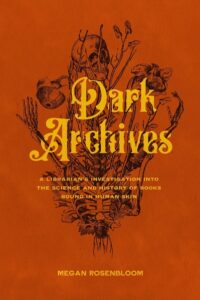 Quite honestly, I’m not sure what I could reasonably write following the words “books bound in human skin” that would have any greater power to induce anyone horrified at the prospect of reading a book about such a subject to overcome their aversion, or for that matter that would inspire anyone already keen to take up a such a subject even more willing to do so. Such is the division the long-whispered rumours of anthropodermic book binding has upon people.
Quite honestly, I’m not sure what I could reasonably write following the words “books bound in human skin” that would have any greater power to induce anyone horrified at the prospect of reading a book about such a subject to overcome their aversion, or for that matter that would inspire anyone already keen to take up a such a subject even more willing to do so. Such is the division the long-whispered rumours of anthropodermic book binding has upon people.
Nevertheless, I’ll have a go.
My own awareness of anthropodermic bibliopegy (yes, that is the name for the act of binding books in leather made from human skin) began back in the 1980s during a lecture at Powell’s Books in Portland, Oregon. The lecturer, whose name I now have unfortunately forgotten, delivered an unforgettable presentation on rare and forbidden books that included a segue into the subject of these astonishing cultural artifacts – one of the most important facts about which to remember is that they are far more rare than their notoriety would cause one to assume.
In fact, one of the appendices of Megan Rosenbloom‘s newly published Dark Archives; A Librarian’s Investigation into the Science and History of Books Bound in Human Skin, lists every volume she is allowed to publicly verify as such by the Anthropodermic Book Project to the date of March 2020. Ms. Rosenbloom, the Associate Director for Collection Resources at the University of Southern California’s Norris Medical Library, as well as the co-founder and director of the Death Salon, has – along with her colleagues in the Project – become a world-renowned expert on the subject, pioneering the sleuthing out of suspected anthropodermic volumes from the shelves of the world’s libraries and collections, and submitting them to testing to confirm or deny their respective status.
How she does this, what clues urge her on, is there anything special or unusual about how these books appear, what happens to those that have been confirmed, and why, by whom – and of whom – they were created in the first place are all part of the fascinating narrative Ms. Rosenbloom weaves in her book. However be aware, once taken up, this is a difficult book to put down.
